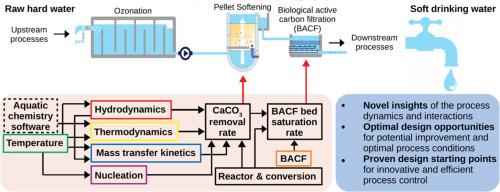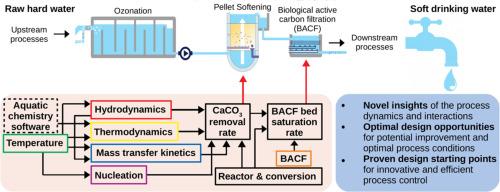Mechanistic model advancements for optimal calcium removal in water treatment: Integral operation improvements and reactor design strategies
IF 11.4
1区 环境科学与生态学
Q1 ENGINEERING, ENVIRONMENTAL
引用次数: 0
Abstract
Drinking water softening has primarily prioritized public health, environmental benefits, social costs and enhanced client comfort. Annually, over 35 billion cubic meters of water is softened worldwide, often utilizing three main techniques: nanofiltration, ion exchange and seeded crystallization by pellet softening. However, recent modifications in pellet softening, including changes in seeding materials and acid conditioning used post-softening, have not fully achieved desired flexibility and optimization. This highlights the need of an integral approach, as drinking water softening is just one step in the drinking water treatment chain, which includes ozonation, softening, biological active carbon filtration (BACF) and sand filtration among others. In addition, pellet softening is often practiced based on operator knowledge, lacking practical key reactor performance indicators (KPIs) for efficient control. For that reason, we propose a newly and improved integral mechanistic model designed to accurately predict (1) calcite removal rates in drinking water through seeded crystallization in pellet softening reactors, (2) the saturation of the filter bed in the subsequent treatment step, (3) values for the KPIs steering the softening efficiency. Our new mechanistic model integrates insights from hydrodynamics, thermodynamics, mass transfer kinetics, nucleation and reactor engineering, focussing on critical variables such as temperature, linear velocity, pellet particle size and saturation index with respect to calcite. Our model was validated with data from the Waternet Weesperkarspel drinking water treatment plant in Amsterdam, The Netherlands, but implies universal applicability for addressing industrial challenges beyond drinking water softening. The implementation of our model proposes five effective KPIs to optimize the softening process, chemical usage, and reactor design. The advantage of this model is that it eliminates the application of numerical methods and fills a significant gap in the field by providing predictions of the carry-over (i.e., the produced CaCO3 fines leaving the fluidized bed) from water softening practices. With our model, the calcium removal rate is predicted with an average standard deviation (SD) of 40 % and the consequential clogging prediction of the BACF bed with an average SD of 130 %. Ultimately, our model provides crucial insights for operational management and decision-making in drinking water treatment plants, steering towards a more circular and environmentally sustainable process.


水处理中最佳除钙的机理模型进展:整体运行改进和反应器设计策略
饮用水软化主要优先考虑公众健康、环境效益、社会成本和提高客户舒适度。全世界每年软化超过 35 Gm3 的水,通常采用三种主要技术:纳滤、离子交换和颗粒软化的种子结晶。然而,最近对颗粒软化技术的改进,包括改变种子材料和软化后的酸调节,并没有完全实现预期的灵活性和优化。这凸显了采用综合方法的必要性,因为饮用水软化只是饮用水处理链中的一个步骤,该处理链包括臭氧处理、软化、生物活性碳过滤 (BACF) 和砂滤等。此外,颗粒软化通常是根据操作人员的知识来进行的,缺乏实用的关键反应器性能指标(KPI)来进行有效控制。为此,我们提出了一个新的改进型整体机械模型,旨在准确预测:(1)通过颗粒软化反应器中的种子结晶,饮用水中方解石的去除率;(2)后续处理步骤中过滤床的饱和度;(3)指导软化效率的关键绩效指标值。我们的新机理模型综合了流体力学、热力学、传质动力学、成核和反应器工程学的观点,重点关注温度、线速度、颗粒粒度和方解石饱和指数等关键变量。我们的模型通过荷兰阿姆斯特丹 Waternet Weesperkarspel 饮用水处理厂的数据进行了验证,但也意味着该模型普遍适用于应对饮用水软化以外的工业挑战。我们模型的实施提出了五个有效的关键绩效指标,以优化软化工艺、化学品使用和反应器设计。该模型的优势在于它无需应用数值方法,并通过预测软化水实践中的结转(即离开流化床时产生的 CaCO3 细粒)填补了该领域的重大空白。通过我们的模型,钙去除率的平均标准偏差 (SD) 为 40%,而 BACF 床的相应堵塞预测平均 SD 为 130%。最终,我们的模型为饮用水处理厂的运营管理和决策提供了重要的启示,使其朝着更加循环和环境可持续的方向发展。
本文章由计算机程序翻译,如有差异,请以英文原文为准。
求助全文
约1分钟内获得全文
求助全文
来源期刊

Water Research
环境科学-工程:环境
CiteScore
20.80
自引率
9.40%
发文量
1307
审稿时长
38 days
期刊介绍:
Water Research, along with its open access companion journal Water Research X, serves as a platform for publishing original research papers covering various aspects of the science and technology related to the anthropogenic water cycle, water quality, and its management worldwide. The audience targeted by the journal comprises biologists, chemical engineers, chemists, civil engineers, environmental engineers, limnologists, and microbiologists. The scope of the journal include:
•Treatment processes for water and wastewaters (municipal, agricultural, industrial, and on-site treatment), including resource recovery and residuals management;
•Urban hydrology including sewer systems, stormwater management, and green infrastructure;
•Drinking water treatment and distribution;
•Potable and non-potable water reuse;
•Sanitation, public health, and risk assessment;
•Anaerobic digestion, solid and hazardous waste management, including source characterization and the effects and control of leachates and gaseous emissions;
•Contaminants (chemical, microbial, anthropogenic particles such as nanoparticles or microplastics) and related water quality sensing, monitoring, fate, and assessment;
•Anthropogenic impacts on inland, tidal, coastal and urban waters, focusing on surface and ground waters, and point and non-point sources of pollution;
•Environmental restoration, linked to surface water, groundwater and groundwater remediation;
•Analysis of the interfaces between sediments and water, and between water and atmosphere, focusing specifically on anthropogenic impacts;
•Mathematical modelling, systems analysis, machine learning, and beneficial use of big data related to the anthropogenic water cycle;
•Socio-economic, policy, and regulations studies.
 求助内容:
求助内容: 应助结果提醒方式:
应助结果提醒方式:


